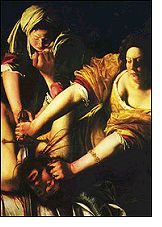
Feature Archive |
| Scandale: The Salons | |
| Revenge: Artimesia Gentileschi | |
| Sittings from Hell: Sargent/Carnation, Lily, Lily, Rose | |
| Private Commissions: Khalil Bey | |
| Rejected Portraits: Kahlo/The Suicide of Dorothy Hale | |
| Villains: Fra Bartolommeo/Savonarola | |
| Surprises: Rembrandt |
Revenge can be the purest and most satisfying of human motivations. Of course, there are countless examples of artists with an I'll-show-those-unbelievers desire for vindication. But in a few cases painters have used their brushes to sort out much more personal grievances.
Anne-Louis Girodet de Roussy-Trioson painted a portrait of a famous actress who found it unflattering and refused to pay, even demanding that it be removed from view at the Salon. Girodet vented his anger by painting the actress stark naked as Danaë, a mythological princess who was visited (and impregnated) by Zeus, who took the magical form of a shower of gold. Various allegorical elements in the Portrait of Mlle. Lange as Danaë reveal her as greedy, vain and adulterous.
At least one author has suggested that Salvador Dalí painted Young Virgin Auto-Sodomized by her own Chastity as revenge against his own sister for contradicting his personal mythology by publishing an account of the artist's happy, normal, middle-class childhood. The painting shows a woman naked from the rear, constructed by and surrounded by rhinoceros-horn phallic symbols (it is now, appropriately enough, part of the Playboy Magazine art collection).
 But the most vengeful of them all must be Artemisia Gentileschi, daughter of the 17th-century painter Orazio Gentileschi. She followed in his footsteps and was sent to study art in the studio of Agostino Tassi, where she was sexually harassed and eventually raped (Tassi was tried and jailed for the rape).
But the most vengeful of them all must be Artemisia Gentileschi, daughter of the 17th-century painter Orazio Gentileschi. She followed in his footsteps and was sent to study art in the studio of Agostino Tassi, where she was sexually harassed and eventually raped (Tassi was tried and jailed for the rape).Gentileschi is best remembered for at least five paintings of remarkable power describing the Biblical incident of Judith Beheading Holofernes. In the story, the beautiful Judith uses wile and guile get into the tent of Holofernes, general of the enemy Assyrian forces, who intends to seduce her. Judith gets him so drunk that he passes out, at which point she grabs his hair and cuts off his head with his own sword, paving the way for Jewish defenders to rout his now-leaderless army. The analogy to Gentileschi's own situation is obvious, and it is impossible not to see these paintings as an expression of rage against Tassi in particular and patriarchal society in general.
Gentileschi also happened to paint the story of Jael and Sisera, in which Jael drives a tent peg into the head of her drugged and unconscious rapist Sisera. It's a lesser-known work without the strength of composition of the Judith paintings, but the image is unforgettable nonetheless.
Additional Resources:
Click here to read more about the life and works of Artemisia Gentileschi
| Continue to next page: Sittings from Hell |
This article is copyright 2000 by John Malyon. Please do not republish any portion of this article without written permission.
John Malyon can be contacted at jmalyon@artcyclopedia.com